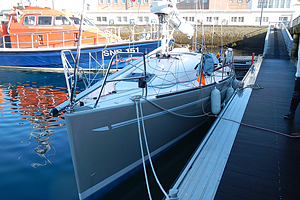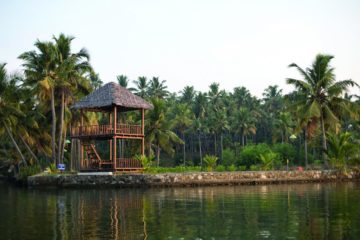
ADVENTURES OUT AT SEA
Yachting is not a particularly popular sport or pastime around here. The reasons are manifold, and I’m not going to get into them now, the main one being that during the communist regime sea access was limited and subject to various regulations. Thus, we don’t have a sea sailing tradition, and, for most, choosing the sea as a holiday destination involves spending the entire time in a resort, on the beach, never venturing outside the buoy marked safe waters. There is, however, a small contingent of sailing enthusiasts living inside of a bubble where yachting is a central part of their existence – we are “Jamaica’s bobsled team”, we live with the sea in our souls, whether sailing for leisure, partaking in competitions or just biding our time at a boat show or theme party.
My husband, my brother and I enjoy yachting, and we participate in many Black Sea races on our sailboat Simina (www.siminateam.ro). When my husband decided to buy a second sailboat from England and bring it over by sea, sailing, with no engine, at the mercy of the wind all the way from Southampton to Mangalia, over a distance of about 3200 miles, not stopping in any ports, mid autumn, all those inside the “enthusiasts bubble” thought he might be out of his mind. They questioned our need for a second boat and, mostly, why all the way from England, but when you have a dream and the adrenaline is rushing through your veins, nothing seems impossible – not even starting a Romanian yachting school, that being, in fact, the reason behind requisitioning this second boat that was to become a school-boat. There are, in our country, some ten regattas each year, and we know we can help raise the yachting level this way. So it was then we decided that Simina, the boat we had already been entering in various local competitions for the past several years, was going to get a younger sister, Simina 2.
The preparations began immediately after we arrived at the decision to buy the boat, the first step being putting together a crew. Since they were to spend a little over a month together on the boat, it was important they would be not only be well prepared to face the sea and rough weather, but also people that would be easy to live with. Eventually, Victor chose to set sail alongside Alex Micu, Ștefan Munteanu and Andrei Popa. They had all been yachting for many years, Alex with the most impressive yachting competition CV, while Andrei and Ștefan were members of Simina’s crew, so part of the family. Except for Alex, none of the four had undergone a journey of this extent. Yachting not very well known in Romania, and it’s perceived as a warm season activity, starting from May to October. Therefore, most of the equipment on hand at the time was inadequate against the foreseeable cold weather.
The four started compiling lists upon lists, calculating water supplies and food provisions, gathering the necessary instruments for the trip – the ones the boat didn’t already have. A serious challenge was posed by the amount of water they could take in the ship’s tanks. Many calculations and brainstorms later, the conclusion they arrived at was that the only viable solution to insure the month’s worth of fresh water would be to buy a manual desalinator, and leave with full tanks of drinking water. The food issue, and the vast amount of space it would take on board the ship, was solved by acquiring a number of dehydrated food boxes, basically fine dust that would then have boiling water poured over them (before their departure, we tested the baked potatoes and salmon, which proved surprisingly tasty). To ensure their vitamin intake, they had green apples and lemons, and against sea sickness, ginger and homeopathic medication. Clothes, too, were picked with volume and weight in mind.
The boat in question is an Elan 340, ten meter long equivalent, with a 1.4 metric ton maximum load – you can imagine everything was calculated with utmost accuracy in order to stay within these limitations. Two weeks of packing later, everything was loaded in the car and the guys squeezed themselves in amongst the sleeping bags, solar panels, desalinator, lifejackets, lifeboat et al. and left for Southampton. The initial enthusiasm made the 2800km trip seem like a walk in the park. Once there, hearts filled with anticipation, they began inspecting the boat they were laying their eyes on for the first time. Although a specialized company had already performed a technical check on the boat and it had been deemed seaworthy, a few minor problems were stil discovered that had to be taken care of on the spot. One detail I forgot to mention: during this whole time rain was constantly pouring down over Southampton.
For the weather forecast, Victor chose to use an application called Weather 4D he could check from his iPad. At the same time, he would check into a routing program called Expedition that’s also being used by some of the competitors in the Volvo Ocean Race, one that integrates weather forecast, maritime maps and the boat’s positioning and heading. He therefore needed an internet connection – something that’s not always available when far out at sea. They had a phone with satellite connection, with a prepaid SIM card, they could use to get a weather forecast, but the download speed was too low to be really efficient. All the while, several friends and family members kept checking various forecasts around the clock and sending the relevant information through text messages.
At the beginning of the trip – while crossing the English Channel – the forecast proved accurate: strong headwind, 4 meters high waves, rain, cold and damp weather. When the wind blows directly from the front, boats have to zigzag at 35-40 degrees off its direction, which is called close-hauled sailing, the boat’s speed and VMG being at their lowest in this kind of wind (VMG stands for Velocity Made Good, and is the speed at which you progress towards the direction from where the wind is blowing). The four would take six hours shifts in pairs: three hours skipper, three crew, six rest. The first 24 hours were pretty hard, particularly on Andrei who was severely sea sick. Fortunately, the wind eventually let down and the waves decreased in height so he felt better, but the worst was yet to come. The next day was one without any wind at all, so they held position, trying to fix the damage caused by the previous day’s storm. One of the side windows was shattered, letting plenty of water inside the boat, a sail was torn and several sheets were showing signs of wear and tear hinting it wouldn’t be long before they would give.
The wind picked up again later that evening, then built up to 35 knots bursts, the waves reaching over six meters. The boat was cutting fast through the waves and the adrenaline was rushing through the entire crew. One issue that suddenly became obvious was the boat had no heating system. And since the outside temperature was 8ËšC, inside it didn’t go over 14ËšC. Freezing, soaked to the bone and with no foreseeable chance of getting any drier or warmer in the near future, the weather forecast announcing even stronger winds during the next few hours, they decided to make a stop in Brest and take cover from the storm. Don’t think, however, they suddenly turned into tourists and went for a tour of the city; as soon as dawn broke, they began repairing and cleaning up the boat, washing their clothes and preparing to get going again. The weather wasn’t “on their side” as sports commentators would put it, the wind and rain didn’t seem to let down at all and since they strayed from their initial plan of not stopping over in any port their morale was halfcrushed.
A big challenge lay ahead though: crossing the Bay of Biscay, well known for its changing weather and strong winds. Anchors away, they checked each knot thrice, took a deep breath and set sail. Twice they attempted to sail across the bay, with increasingly strong headwind, but in the end the freezing cold (5ËšC outside temperatures, combined with a 40 knots wind, making for a wind chill of -3ËšC) got the better of them. The decided to postpone the adventure until the following spring, when the weather would be more merciful and they would have installed a heating system. They therefore went ashore in the Brest docks where they took the boat out of the water for the winter, and they themselves returned home – somewhat beaten, but satisfied they had tried everything humanly possible.
From a strictly pragmatic stand point, they failed in the challenge they set for themselves – sailing the boat over from Southampton to Mangalia in an uninterrupted trip. They weren’t sufficiently prepared, and the weather made things worse – you can’t prepare for the unpredictable.A wise saying goes “best-laid plans of mice and men oft go astray”, but that, I believe, is the beauty of yachting. They’ll be back come spring, more motivated and better prepared, and they’ll sail the boat over the remaining 2900 nautical miles to Mangalia, and I will continue to tell their adventure So, to be continued…









